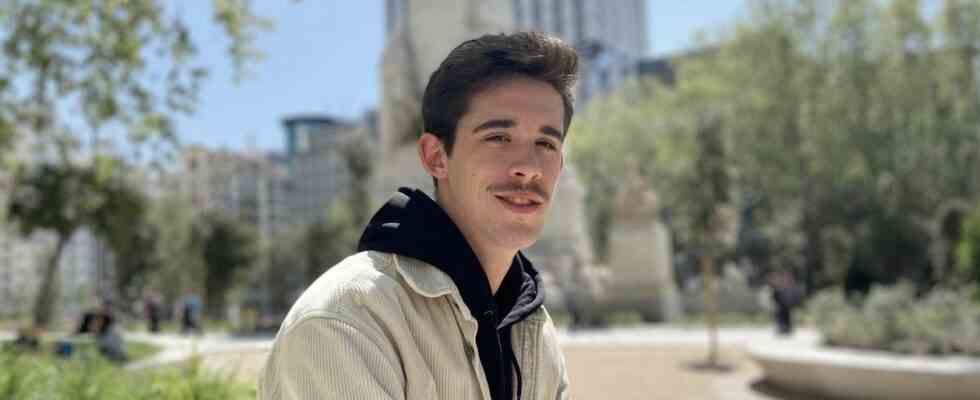Born in 2000, he “grew up with the tram site” and “bathed in works in Bordeaux. ” ” It has always fascinated me and I have always had an opinion on what he was doing. Naturally, the Bordelais William Boy was destined for a career as an architect, and joined the Bordeaux School of Architecture, where he is now in Master 1.
“Bordeaux quickly became a playground for me, and I started to redesign places, public spaces, it was very personal and it was not intended to be broadcast,” he explains. Until the first confinement, during which he began to work on 3D software, and decided to publish his work on social networks. Cours de la Marne, Place Ravezies, the alleys of Tourny… He thus rethinks the squares and strategic axes of the city.
Qualified as a “swindler” or “child of Hurmic” on the networks
“One of the first projects I published was the plot on rue de Tivoli in front of the Bernard Magrez Institute, it didn’t arouse delirious enthusiasm, but the reactions were rather positive, it pushed me to continue , and honestly I didn’t think it would be so successful. Indeed, the quality of his work is generally praised.
But who says social networks says haters, and the young Bordeaux man is also accused of being in turn a “swindler” or a “yuppie”, presented as a “child of Hurmic” who only “thinks about turning cars and putting trees and pedestrians everywhere”, when he is not tried for a youth crime, “never confronted with town planning rules. Ouch.
A vision “halfway between that of Juppé and that of Hurmic”
Criticisms, when they are not insults, which marked the student. When questioned from Madrid where he is continuing his studies, William Boy pays attention to words, anticipates the clashes to come, on subjects that he knows are eminently divisive and politically sensitive. He warns that his vision may have evolved between entering architecture school and now. But play the transparency. A member of the Vélo Cité and Métro de Bordeaux associations, he does not hide his preferences, which go towards soft mobility and the greening of the city. He acknowledges that he can have “clear opinions on urban policies, but as much concerning the old municipality as the new one. »
“I don’t want to put myself in a box, there are things done by Juppé that I really like, just as I also appreciate the achievements of the current town hall. I find that Juppé’s creations were more polished, more aesthetic, but he didn’t give enough thought to soft mobility. The best example is Place Gambetta: it is magnificent but mobility has been forgotten, and trees have been cut down. »
For its part, “the new municipality is more committed to the issue of new mobility and has a desire to go faster, but the achievements are not necessarily very good. On revegetation for example, I am in favor of it, but we cannot put microforests everywhere either, knowing in addition that there is not even a consensus on their usefulness. It seems to me that the new municipality sometimes forgets that we are in a historic city, where there is heritage to take into account. For me, the city must be pleasant to live in, and my vision, ultimately, is halfway between that of Juppé and that of Hurmic. »
“Some of our elected officials are disconnected”
One of his latest publications concerns a redevelopment of the Tourny alleys. “Unlike others, it’s a fairly consensual project, where I close one side of the street, I remove parking spaces – taking into account the existence of an underground car park – I put mobility soft, a significant vegetation but rather low to preserve the perspective on the Grand Theater and to hide the facades as little as possible and to respect the city of stone. »

He also made 3D images for the Bordeaux Metro association, such as the Médoquine station and the course of the Marne. “A metro in Bordeaux seems essential to me, I think that some of our elected officials are disconnected, and I’m not sure they take the tram every morning… This would also free up space on the surface to have a city more pleasant to live in, knowing that in some places the historic city is too narrow to pass enough things. »
On the bike, “in Bordeaux, we are still in the small ends”
As for his immoderate defense of the bike, he assumes it. “I’m doing my thesis on how cycling is essential for the sustainable development of cities, and I’m back from Utrecht [Pays-Bas], a cycling paradise, with the largest bicycle parking lot in the world. It’s very impressive to see how well everything works there. This does not mean that I am campaigning for a 100% bicycle city, but there are plenty of routes that you can take without a car. This is why, in my opinion, it is necessary to carry out a colored marking on the ground for the bicycle, this would limit the conflicts of use and would create continuity in order to have a real network. In Bordeaux, we are still in the small ends. »
A vision of a peaceful city, which forgets disabled people, as it is also criticized for? “Not at all, defends the student, as if the car were the best ally of people with reduced mobility… No, precisely, widening the sidewalks, taking up space for the car, is also giving space People with Disabilities. »

